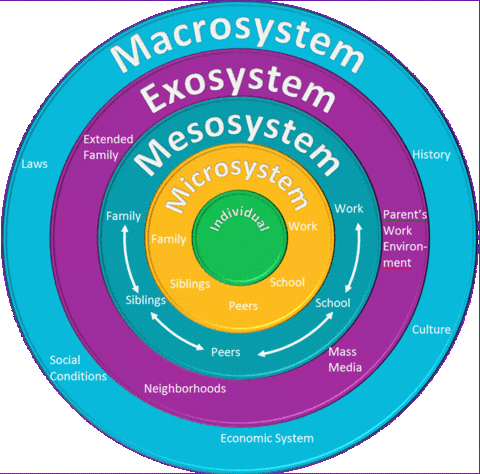Lesson 5: The Theory behind Case Management
Attention

Urie Bronfenbrenner was an American developmental psychologist—but born in the Soviet Union—who is most known for his Ecological Systems Theory of child development.
Learning Outcomes
Upon completion of this lesson's material, students will be able to:
- Explain the importance of community inclusion and natural supports
- Demonstrate knowledge about changing treatment needs for adult stages of transition
Teaching
The Ecological Model approach to CM calls for us to look at the client as a whole and in context in a social world. We can describe the context of the client in three levels Macro, Meso and Micro. When we look at the Macro level we examine society's characteristics and how they come to bear on the individual. The Meso level is more personal. This is the context immediately surrounding the client. The client's community, family, friends, church and co-workers are included in this layer. The Micro level focuses specifically on the client. It looks at the client's personality, motivations and personal characteristics.
The ecological model arises from the work of Urie Brofenbrenner, a Psychologist.
The Brofenbrenner Center for Translational Research at Cornell University

Wiki actually has a really good description of this theory HERE.
The graphic below exemplifies the relationships that exist among the different levels of interaction in a person's world. First there is a general model and then how it may be applied to a school situation

This model is actually a developmental model of human development. As persons age and experience the world, the different concentric circles of influence begin to have an impact on the development of the person.
When we work with people we often can implement change in a persons well-being by implementing change in one of the outer rings.
So, we combine theories of human development (such as Erikson) with this theory to help us understand where someone is at.
This app is called Caseload Free and is free. This app allows users to create one case in the app for free. Starting next week you will be meeting with a "client" on two different occassions. Once to complete an Intake and the second to develop a treatment plan. Once you determine who your client will be (you can use a classmate or a friend or family member) you will use this app to keep track of your work with this client. The first step will be to add your client (using a different name to protect your volunteer's confidentiality). Then proceed to add in client details such as information about when you are scheduled to meet with the person. You will then document case notes, referrals and phone calls/contacts based on the interactions you will be having with this client over the next few weeks. As you proceed through your work with them you will be asked to add additional information into the app to gain practice in how to keep track of appointments and tasks.
The app does have a purchase version but for theses lessons we are working in the free app. |
Assessment
Lesson 5 Discussion
Using the Wiki source in the Lesson, review each of the components of Brofenbrenner's theory. Describe situations you may encounter in any one of the systems. Relate a story from your own life that exemplifies how these different levels of context have interacted with one another.
Lesson 5 Quiz
- Select one of the "systems" from the theory and describe how a case manager may create a plan that would be directly influencing this system. (You can make up a story or use one from the discussion or your personal experience.)

